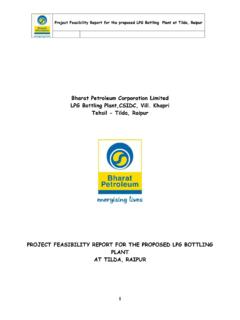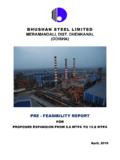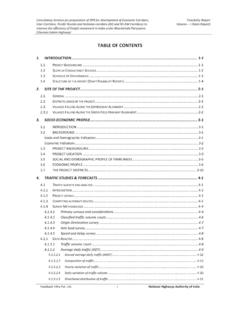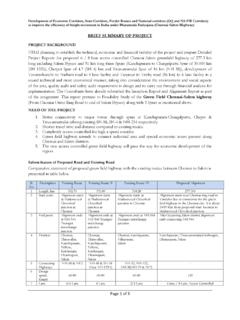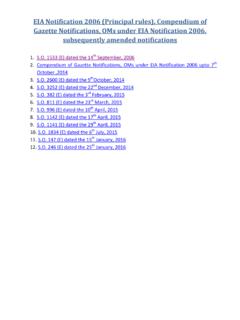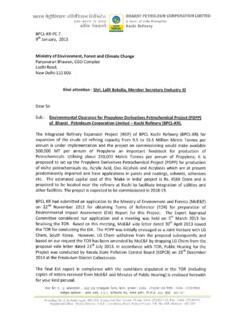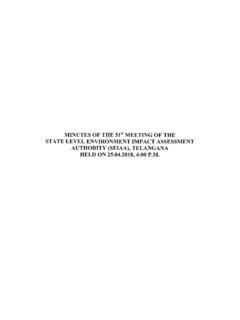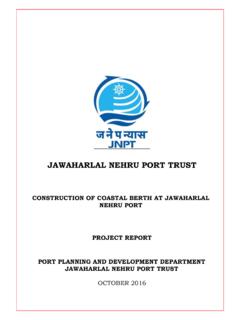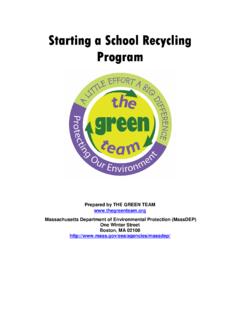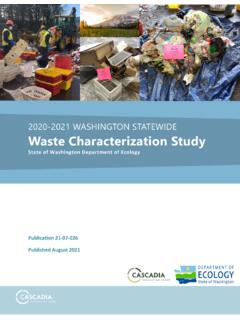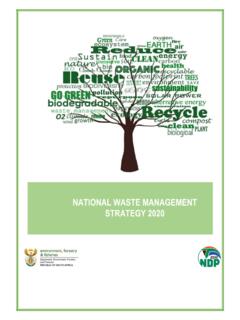Transcription of ENVIRONMENTAL MANAGEMENT PLAN 1. OBJECTIVE
1 ENVIRONMENTAL MANAGEMENT plan 1. OBJECTIVE The OBJECTIVE of ENVIRONMENTAL MANAGEMENT plan (EMP) is to formulate measures which will: 1. Mitigate adverse impacts on various ENVIRONMENTAL components, which have been identified during the rapid ENVIRONMENTAL impact assessment study. 2. Protect ENVIRONMENTAL resources where possible. 3. Enhance the value of ENVIRONMENTAL components where possible. EMP also includes a monitoring plan to enable evaluation of the success or failure of ENVIRONMENTAL MANAGEMENT measures, and to carry out reorientation of the plan if found necessary. It is emphasized that many of the protective and enhancement measures can be implemented by adopting suitable planning and design criteria for construction of the project.
2 2. LAND ENVIRONMENT Traffic MANAGEMENT Construction Phase There will be no major impact on the land environment during construction phase as identified during studies. The internal roads will be designed with adequate widths to minimize traffic congestion due to the movement of trucks carrying raw materials required for construction. Special care will be taken during transportation of construction material like cement, sand, aggregate etc. as considerable quantities of such material would be transported from various material suppliers. The material will be sourced from the nearest available government approved contractor. Since the road transport is unavoidable, such movement will be carried out during non- peak hours as far as possible.
3 Operation Phase The impact on land environment during operation phase will be due to movement of vehicles of residents and users of the hotels, commercial facilities and amenity area. Precautions to be taken to minimize impacts on land environment will be as follows: Development will be as per local guidelines for Residential Development. Adequate measures will be taken considering the natural drains by incorporating design elements like steep land landscaping etc. There will be minimum amount of cut and fill to reduce disturbance to the existing surface water hydrology Natural drain lines which fall in the path of proposed roads will be maintained as far as possible through construction of culverts.
4 Adequate provisions will be made through provision of internal roads of minimum 9m width for smooth vehicle entry and exit. Approach road (external road) and internal roads for onsite traffic movement will be planned as per project development. solid waste MANAGEMENT The salient features of the proposed solid waste MANAGEMENT strategy are as follows: For waste generated during the construction phase, gross segregation of waste into roadwork materials, structural building material and salvaged building parts will be made. Additional segregation to facilitate reuse/ recycling will be made. Material wastes like bricks, cement etc. will be used as fill material and concrete will be recycled and reused at the site.
5 Adequate facilities for the storage of these waste materials would be made on site. MANAGEMENT of solid waste generated during the operation phase would include collection, transportation and disposal in a manner so as to cause minimal ENVIRONMENTAL impact. It will be made mandatory for waste to be segregated right at the source of waste generation. Collection of segregated waste would be made from the residential areas, resorts, hotels and commercial and amenity areas. There would be manual collection & storage of biodegradable waste at the ground level; and Reusable and recyclable waste would be manually collected and stored in closed rooms at ambient temperatures. Biodegradable waste from residential buildings, commercial blocks would be transferred to mechanical composting units within the site for disposal.
6 Compost from the same will be used for landscaping. Reusable and recyclable waste will be disposed by selling to scrap dealers and private contractor for resale. Non-degradable waste will be transferred to municipal solid waste MANAGEMENT system. 3. AIR POLLUTION Construction Phase a) Mobile source emissions 1. Transportation of raw materials required for construction will be carried out during non-peak hours. 2. Idling of delivery trucks or other equipment will not be permitted during unloading or when not in active use. 3. To minimize dust emissions due to trucks carrying cement, gravel, sand to site, ready mix concrete carried in enclosed container will be used which is a better option as compared to on site batch mixing.
7 4. Dust covers will be provided on trucks used for transportation of materials prone to fugitive dust emissions. 5. Covering scaffolding and cleaning of vehicles which can reduce dust and vapor emissions will be used. b) Stationary source emissions 1. Most of the machinery related to construction will be located close to construction area for ease of handling. 2. Machinery such as conveyers and mixers will be screened with sheets of suitable material to reduce transport of suspended particulate matter and noise. 3. All stationary construction equipment will be located as far away as possible from sensitive receptor locations in order to allow maximum dispersion of emitted pollutants.
8 4. Areas prone to fugitive dust emissions due to activities such as excavation, grading sites and routes of delivery vehicles across patches of exposed earth, will be frequently water sprinkled to prevent re-entrainment of dust. 5. Hosing down road surfaces especially if they are unfinished surfaces also helps to prevent fugitive dust emissions. 6. Other measures include appropriate containment around bulk storage tanks and materials stores to prevent spillages entering watercourses. 7. Apart from these, equipment/ machines and vehicles will be always kept in good state of repair to minimize emissions. Construction areas will be enclosed, wherever possible. Operation Phase 1. Plantation along the roadside helps to reduce effects of air/ noise pollution.
9 A row of trees will be planted along the plot periphery to screen the site from air/ noise pollution. 2. Regular maintenance and upkeep of the internal road within project will ensure smooth traffic flow and will help to reduce air pollution. 3. As per the project analysis, the impact of proposed project would be positive when proper traffic flow is maintained. The entrance/ exit to the site will be maintained so that there are no obstructions to traffic flow as also road side parking will be avoided. 4. NOISE POLLUTION Construction Phase 1. Construction contract specifications will specify use of equipment generating noise of not greater than 90 dB (A). 2. Contract specifications for construction will stipulate levels of maximum noise generation in various zones based on CPCB Noise Standards.
10 3. High noise generating construction activities like, compacting etc. will be carried out only during day time. 4. Workers working near high noise construction machinery will be provided with ear muffs/ ear plugs. 5. Provision of temporary barricading around site. Operation Phase During operation phase it is important to maintain the noise levels within the plot for the safety and better health of residents and users. The various precautions to be taken to maintain acceptable noise level within the project area are as under: 1. Buffer in form of wall or tree plantation will be provided along the main roads 2. Green belt would be essential adjacent to sensitive locations like reserve forest areas, lakes etc.

